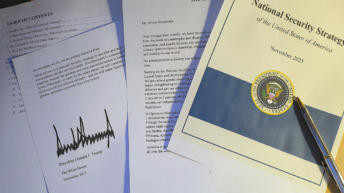
As India marks the centenary of the Rashtriya Swayamsevak Sangh (RSS), the movement’s influence on national security has reached an unprecedented level. Yet the institutional role of the RSS cannot be separated from the political leadership of Prime Minister Narendra Modi, whose nationalism has transformed the Sangh’s civilisational ideals into an operational language of strategy. From the 2016–2019 retaliatory strikes to Operation Sindoor (2025), India’s evolving doctrine of deterrence has fused moral conviction, technological confidence, and national identity into a single narrative of strategic purpose.
On 2 October 2025, India marked the centenary of the RSS, the world’s largest volunteer organisation and the ideological driving force behind Hindu nationalism. Prime Minister Narendra Modi described the RSS as “the embodiment of India’s eternal national consciousness.”[1] Beyond ceremonial tribute, the remark highlighted a more profound shift: civilisational ideas have moved from the cultural domain into the centre of India’s national security framework. Over the past decade, the Modi government has redefined power as a combination of ethics, identity, and strength. This has led to what might be called a “doctrine of moral deterrence,” in which security is not only physical but also moral, and national resilience is seen as an extension of civilisational self-awareness.
From Movement to Strategic Blueprint
Founded in 1925 by Keshav Baliram Hedgewar, the RSS began as a social initiative focused on “nation-building through character-building.” Under Modi, its worldview has evolved into a guiding principle of governance. The Sangh regards India as Bharat, a civilisational entity rather than a typical nation-state. In this view, security is not only about defending borders; it involves safeguarding a way of life. This ethos underpins India’s three main strategic pillars today:
- Self-Reliance (Atmanirbhar Bharat): Economic and technological sovereignty as moral autonomy.
- Societal Resilience: Unity and discipline as deterrence.
- Civilisational Diplomacy: Engagement without dependence, guided by cultural legitimacy.
Through its nationwide network of schools, charities, and volunteer groups, RSS cadres act as first responders during natural disasters, pandemics, and internal crises, instilling security consciousness at the grassroots level. This civic infrastructure converts patriotism into participation, transforming resilience from a policy goal into a lived social ethic. The result is a model of “societal defence”, where moral discipline and national unity amplify state power from below. It exemplifies a distinctive Indian understanding of security as a shared moral ecosystem.
From Restraint to Moral Deterrence
Since 2016, India’s deterrence posture has evolved through decisive responses such as the Balakot airstrikes and Operation Sindoor (2025). These were not only military operations but moral performances—asserting that India’s use of force is precise, limited, and justifiable. The RSS concept of Dharma Yudh (righteous struggle) provides the philosophical vocabulary for this transformation.
Operation Sindoor, launched in May 2025 in response to the Pahalgam terror attack that killed 26 civilians, marks a significant milestone in India’s evolving security doctrine in the face of Pakistan-sponsored cross-border terrorism. This process, which began with the Uri (2016) and Pulwama-Balakot (2019) incidents, signifies a shift from a “strategic containment” approach and symbolic responses to a strategy of “Deterrence by Punishment”, which involves imposing real costs on the Pakistani terrorist infrastructure and military establishment.
Until 2016, Indian security policy tended to avoid a direct military response to major terrorist incidents, such as the terrorist attack on Parliament (2001) or on Mumbai (2008), favouring “strategic restraint” while relying on diplomatic pressure. In Uri (2016), India first conducted covert and limited special forces raids across the Line of Control (LoC). This symbolic move conveyed a message of a change in consciousness but remained at the level of a targeted operation, allowing Pakistan reasonable room for denial. Pulwama/Balakot (2019) marked a fundamental shift: India used air power in undisputed Pakistani territory for the first time since 1971, thereby creating a model of deterrence by threat. The goal was twofold: to demonstrate the seriousness of the intent and to make a controlled risk that would serve as a deterrent in the future.
Operation Sindoor represented another phase in doctrinal development, shifting from “deterrence by threat” to “deterrence by direct and sustained punishment” and establishing a “New Normal” in Indo-Pakistani relations. India announced that Pakistan-sponsored terror attacks will be regarded as an act of war warranting military response, with Prime Minister Modi emphasising that this is Delhi’s new default stance. India declared that it would view terrorist organisations and their military sponsors as a single target, thus justifying attacks on Pakistani military installations.
The operation demonstrated the shift towards widespread use of long-range precision weapons, such as the BrahMos cruise missile, SCALP-EG, and Harop-type homing munitions, which enable control over escalation and eliminate the need for large-scale ground forces. This renders the Cold Start doctrine obsolete. Striking nine initial targets, including locations deep inside Pakistan that had not been attacked since 1971, such as the Rafique, Murid, Noor Khan, Sukkur, and Sialkot air bases, was intended to impose a real cost on the Pakistani military-terrorist complex.
Operation Sindoor also highlighted the tri-service response and effectiveness of the Indian air defence system, which combined indigenous (such as Akash and Akashteer) and imported (such as S-400, Barak-8 and SPYDER) systems, under the command of the IACCS control system, which enabled the successful interception of hundreds of Pakistani drones and missiles. Alongside the military attacks, unprecedented political and economic steps were taken, most notably the unilateral suspension of the Indus Waters Treaty, a move that represented an innovative use of geo-economic power.
Nationalism in Operation Sindoor
Operation Sindoor was an expression of Indian nationalism, both at the symbolic–cultural level and at the doctrinal-strategic level. The name itself was a deeply charged political and cultural symbol, serving as a tribute to the widows created in the aftermath of the Pahalgam terrorist attack and also as a symbol of India’s martial traditions and the concept of dharma—righteous duty. In his May 12 address, PM Modi characterised the cross-border strikes as a “new milestone” in India’s counter-terrorism policy, rejecting the assumption that Pakistan’s nuclear posture grants it strategic immunity. Declarations of a military response as the new default, the erasure of distinctions between “terrorists” and their military sponsors, and the public promise to “go in and strike” marked a decisive shift from the doctrine of strategic restraint to one of deterrence by punishment.
Nationalism also extended into the non-kinetic sphere. The unilateral suspension of the Indus Waters Treaty (IWT) demonstrated the use of geo-economic power as a direct expression of nationalist policy, highlighting that even natural resources could serve as tools of strategic coercion. Together, these symbolic, rhetorical, and operational signals projected an image of a leader pursuing a cohesive national agenda to establish a “new normal” in India–Pakistan relations.
Security as a Moral Ecosystem
In 2025, the RSS unveiled the Panch Parivartan (“Five Transformations”), a moral roadmap for India’s next century that doubles as a strategic doctrine:
- Sva-Bodh (Self-Awareness): Overcoming the colonial mindset and restoring civilisational pride.
- Samajik Samrasta (Social Harmony): Unity as the foundation of deterrence.
- Kutumb Prabodhan (Family Awareness): Family as the nucleus of order and discipline.
- Nagrik Shishtachar (Civic Conduct): Discipline as civic virtue.
- Paryavaran (Environment): Ecological stewardship as a driver of national resilience.
This framework expands the definition of security to include moral, social, and environmental dimensions, aligning with India’s holistic vision of comprehensive national power. In foreign policy, Modi’s multi-alignment strategy mirrors the RSS ideal of “cooperation without dependence.”
Strategic Self-Reliance and Technological Sovereignty
India’s achievements in space exploration, from the 2023 lunar south pole landing to the 2024 solar probe, exemplify the combination of self-reliance and moral aspiration. Initiatives like IN-SPACe and iDEX demonstrate how innovation, national pride, and autonomy in security come together. As the Asia Pacific Foundation of Canada notes, India’s space programme “balances commercial opportunity with national security priorities.” For the RSS, such successes embody Atmanirbhar Dharma, with technology serving national dignity.
The convergence of nationalism and security has produced tangible benefits: stronger institutions, more coherent diplomacy, and a unified strategic narrative. The Atlantic Council’s “Modi 3.0” report suggests that the third Modi administration demonstrates an unusual level of strategic coherence. Its combination of political stability and self-assured nationalism has enabled New Delhi to articulate long-term priorities with greater confidence and internal alignment than in previous decades. However, such clarity also imposes limitations: it narrows the space for ambiguity that once provided Indian diplomacy with flexibility, and it raises the question of whether coherence might develop into rigidity when faced with future crises or dissenting domestic voices.
Conclusion
A century after its founding, the RSS has evolved from a cultural movement into the civilisational compass of India’s nationalism. Its language of seva (service), sankalp (resolve), and swadharma (duty) now shapes India’s grammar of power. India’s security today is defined not merely by what it defends, but by what it embodies: the conviction that a once-divided civilisation can regain strength by aligning moral order with strategic ambition.The fusion of Modi’s assertive nationalism with the RSS’s moral framework has produced a uniquely Indian grammar of strategy—one that draws legitimacy from ethics, identity, and technological prowess. Operation Sindoor exemplified this synthesis: a campaign where symbolism, doctrine, and leadership converged to redefine deterrence as both moral and material. For India’s policymakers, the challenge ahead lies in preserving moral confidence without constraining strategic flexibility, thereby ensuring that civilisational conviction continues to serve, rather than define, the Republic’s strategic choices.
[1] https://indianexpress.com/article/india/after-100-years-of-strengthening-nations-soul-rss-journey-into-next-century-begins-pm-modi-10283060/lite/?utm_source=chatgpt.com






Add comment